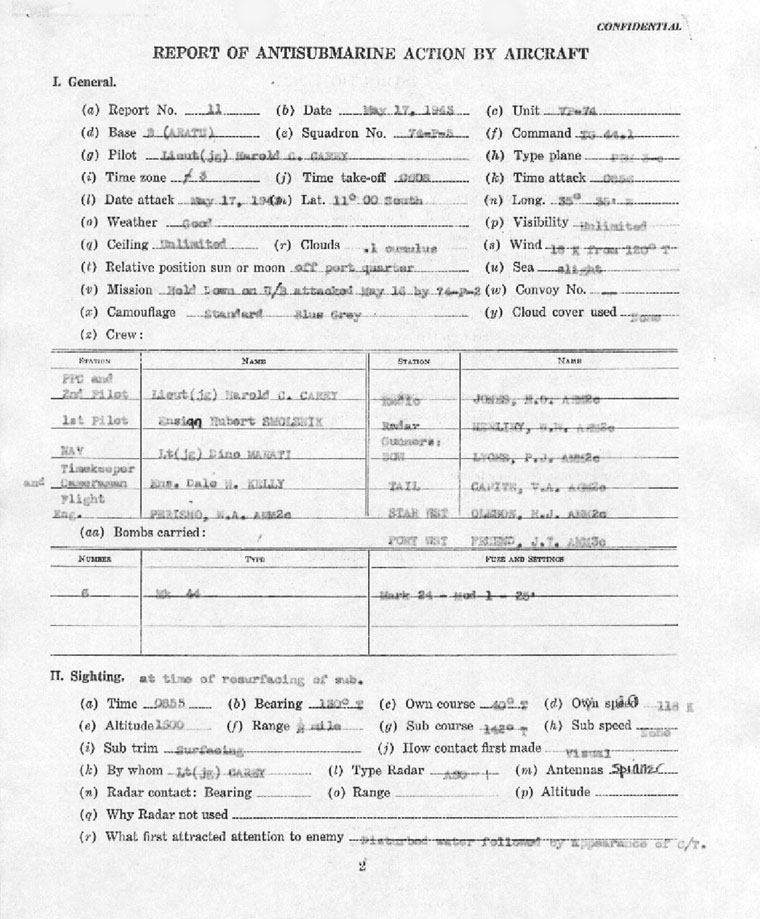

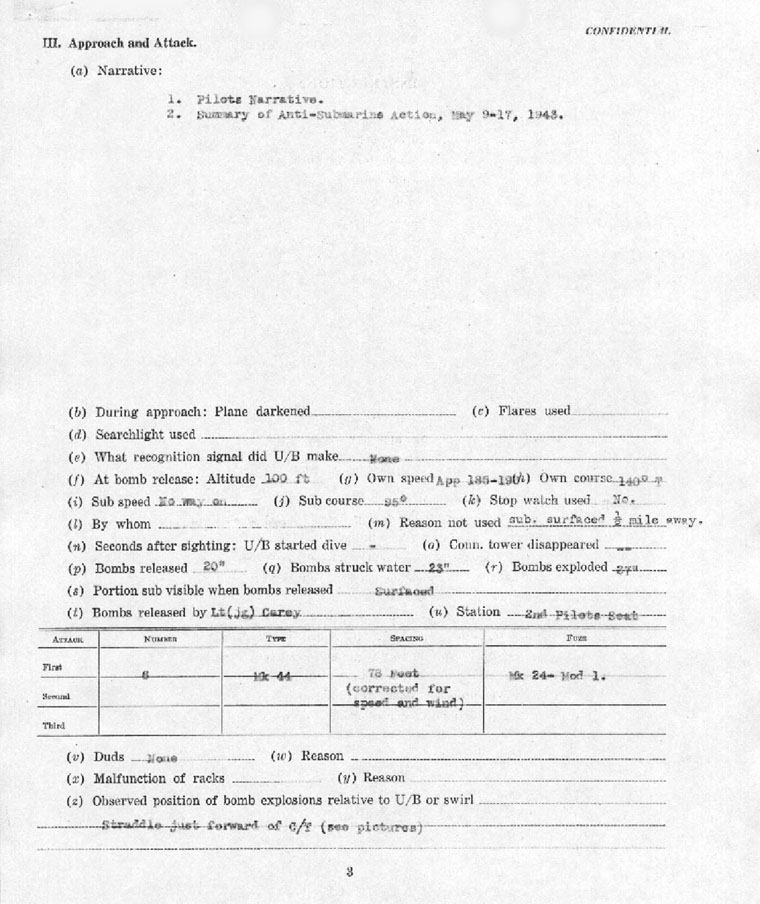
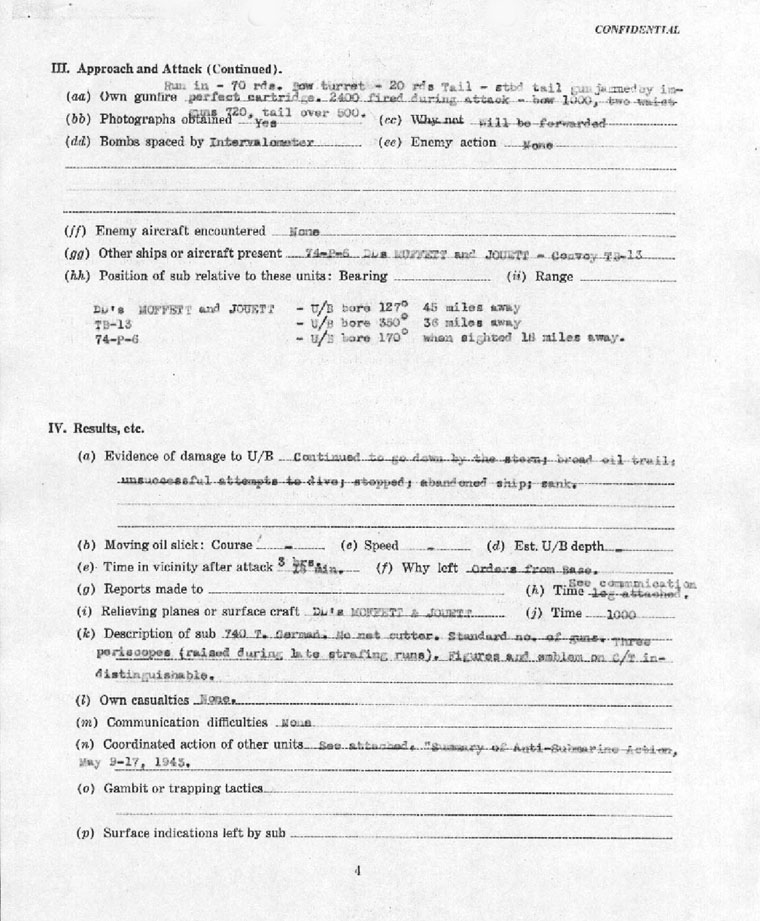
| III(a) NARRATIVE OF PATROL PLANE COMMANDER | ||
| At 0847, on the east leg of an assigned 50-mile square, the radar operator had an indication 28 miles ahead. Weather was good and we were at 6000 feet. Through binoculars, I saw a fully surfaced submarine, and ordered an attack. Ens. Smolsnik, the regular PPC of 74-P-5 was in the seat and I prepared the bomb panel. Soon after the run started, the U/B started to submerge. We then first noted 74-P-6 going in for an attack about two miles ahead of us. By our watch, her bombs exploded 15 seconds after submergence. They straddled the sub’s course about 200 feet ahead of the swirl. We passed over the spot 40 seconds later, withholding bombs. I relieved Ens. Kelly, who had timed the run and taken pictures of the approach, in the second pilot’s seat. We made a complete climbing circle to the right, when I observed the U/B approaching the surface. Ens. Smolsnik dived at 450 to the attack, passing over just ahead of the C/T. I released the bombs from the second pilot’s seat at 100 feet or more of altitude and 185 knots. They straddled and the explosion completely enveloped the submarine. We made the first of about twenty strafing runs within less than a minute of the D/C attack. | ||
| About a minute later, the U/B got under way, leaving in its wake a large amount of oil, and was down by the stern to the aft deck gun. The bow diving planes had apparently been jammed in the up position by the previous attack. After 20 minutes of erratic maneuvering these were fixed, and about four times the U/B tried to dive, once succeeding in submerging to all but one quarter of the C/T. Both planes maintained continuous strafing and on fifth run No. 5 observed a flashing explosion just aft of C/T lasting about a minute, believed to be from ammunition. No. 6 prepared and sent the amplifying report; No. 5 sent MO’s. on Baker 3. After a half hour, when No. 6 went to lead the DD’s to the scene, No. 5 maintained the strafing attacks and kept other planes, the base, and surface ships informed of the progress of events. | ||
| At 0952 the engines stopped, the decks were coming awash, and the crew started to abandon ship. Thinking they might man the guns or that scuttling might be prevented until the destroyers came, we strafed with all guns. Those who came on deck quickly took to the water. About the last ten men were in this process when the MOFFETT & JOUETT arrived at 1001 and started shelling. After four direct hits the sub nosed over and at 1009 sank at a 200 angle. Forty or fifty survivors were picked up by the DD’s. | ||
COMMUNICATIONS LOG OF ATTACK, MAY 17 |
||||||||||||||||||||||||||||||||||||||||||||||||||||||||||||||||||||||||||||||||||||||||||||||||||||||
|
||||||||||||||||||||||||||||||||||||||||||||||||||||||||||||||||||||||||||||||||||||||||||||||||||||||
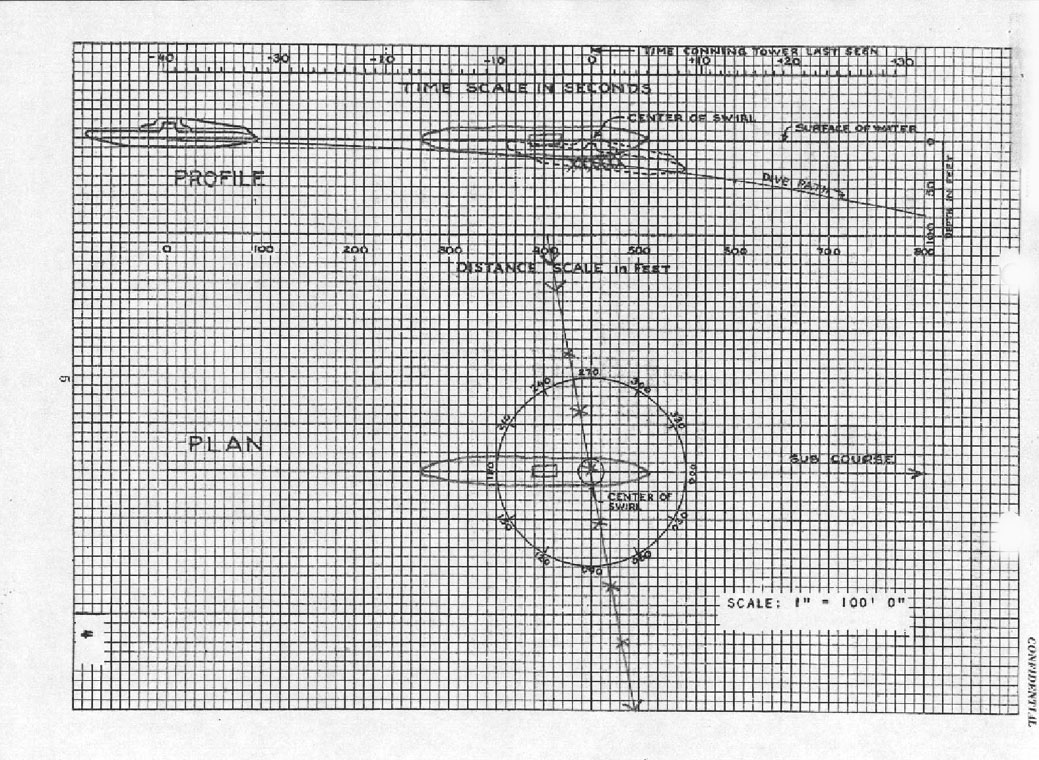
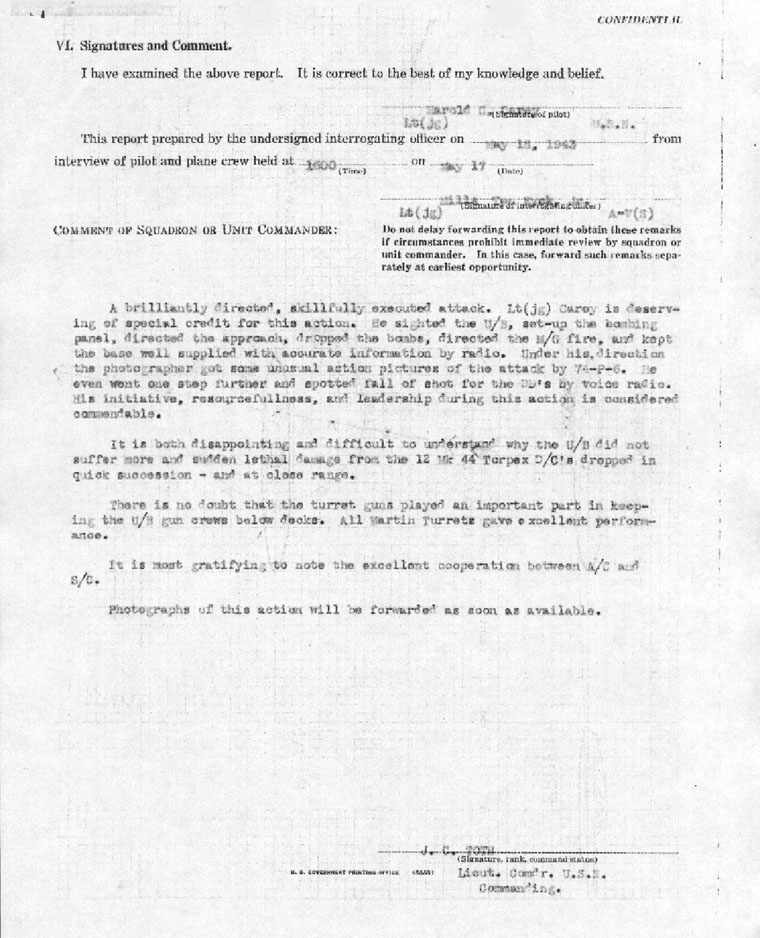
SUMMARY OF ANTI-SUBMARINE ACTION, MAY 9-17, 1943 |
||
| Following an RDF within 100 miles of 130 S, 360 W at 2006 (all times P) May 9, The Commander Fourth Fleet, ordered a sub alert from Recife to Victoria. At 0720 on May 11, 74-P-11 had a distinct radar contact, unlike those continually picked up from rain squalls, at a distance of ten miles in position 10 S, 350 06’ W. The area was thoroughly investigated without results. Thirty minutes later, a radar contacted to an Argentine passenger fruit ship Rio San Juan of Buenos Aires, at 10 S, 34 40 W. When sighted, she was heading true north; but when she sighted the plane she altered course radically to 090 T. Her speed was 15-18 knots. At noon she was sighted again, this time on course 210. The next day 74-P-6 sought her out and found her at 1115 at 15 45 S., 37 48 W., on course 205 T. As on the previous day she was passed close aboard and no one was seen on deck. A little later, 74-P-12 picked up a distinct and similar radar contact 15 miles away, at 12 15 S., and 34 10 W. The indication faded as the area was approached and search revealed nothing. On May 14, BT 13 departed from Bahia. Intensive patrolling was continued. On May 16 at 1120, Lieut. Gibbs took off from Aratu in 74-P-2 to sweep a 200 mile sector to the Northeast. Rain and low ceilings prevailing near the base gave way to .5 cumulus with 2500’ base to which he climbed. At 1351 an object one point on the starboard bow and fifteen miles distant was reported from the bomber’s window. The radar picked up only the shore, 45 miles on the port beam. The pilots in a few seconds saw a white wake and at the end of two minutes identified it through glasses as a submarine with decks awash. The plane was on course 042 T, the U/Boat about 35-40 T. The plane turned slightly toward cloud cover and to get between submarine and the sun, then increased power and came straight in. When about half the distance had been covered, both pilots became convinced that it was submerging. It did, so gradually that no one could say surely when the process began or just when it was completed. Opinions vary from three miles to one mile and from 65 to 20 seconds, all agreeing that the exact point of submergence was impossible to determine. The only watch was held by the second pilot, who measured 65 seconds from the time he last saw the C/T. This time and distance was upheld by four observers. A fifth thought that they came within a mile or at most two, at which point he started to take pictures. The observer in the port waist described a “boiling white wake” at ¼ mile. The first pilot thought “until the last few seconds” that they would reach the submarine still on the surface, and that with ten more knots available they would have done so. | ||
| At 1357 the swirl was reached, still in pronounced motion and distinct. Six MK 44 charges straddled the swirl, the last two 120 feet beyond its leading edge. The plane’s course was almost exactly along the submarine’s track. From the very slow submergence it may be fairly supposed that the plane never was sighted and that the slow rate of descent continued, leaving her within range in depth. She was within range in plan if the attack was in fact made within thirty seconds, the possibility of which is suggested by the pilot’s opinion, the time check of the actions of the man who went aft, and the behavior of the water. Interrogation of prisoners may throw light on this interesting point. | ||
| Lieut. Gibbs offered a thirty mile gambit during which Lieut Voorhies, who was dispatched in 74-P-9 upon receipt of the sighting report , arrived in the area. After two and a half hours No. 2 reached PLE and returned to base. No. 9 maintained hold down, landing at Aracaju, the nearest port, a minute or two before dark. Meanwhile Lieut Esch took off in heavy rain in 74-P-14 a radarless (PBY 5B). He followed the hold down plan devised by Dr. Steinhardt of the ASWRG, a 50-mile square, (modified to stay a reasonable distance from land) | ||
| with the contact point in the center, which he flew across every fourth time. At 2347, at 11 07 S, 35 34 W. a pilot standing in the bow compartment saw in the moonlight a V-shaped wake, course 3000 T. A flare dropped from 1200 feet disclosed only whitecaps. 74-P-9 left Aracaju at 0630 for a brief return to the contact area, during which he located, and reported to plane 6 the position of the destroyers MOFFETT and JOUETT. He also followed up a radar contact to the southbound convoy T B 13, informing the base upon his return of its presence in the area and its position. Returning to base he then passed over what was to be the scene of action, indicating that the submarine was still submerged, and suggesting that it may have surfaced after watching him pass by. | ||
| At 0843 74-P-6, having just passed 74-P-9 homebound, visually sighted a surfaced submarine 18 miles distant. At the same time it was picked up on the radar. No. 5 was well above, somewhat to the left, and an estimated ten miles astern of No. 6, and made both visual and radar contact just before or at the same time. Both started in, No. 6 working to the left somewhat to get the sun more behind it. At 0850 No. 6 dropped six MK 44 DC’s 150’ ahead of the swirl, fifteen seconds after submergence. The drop was observed as a neat straddle of the sub’s projected course. Forty seconds later No. 5 passed over the spot, withholding its bombs. Both planes maneuvered for five minutes, then sighted the bow of the U/Boat, a German 740 tonner, breaking the surface at a sharp angle, a few hundred yards to the left of where it went down and on a reciprocal heading. Lieut. Carey who had climbed to 1500’ now dove at an angle of 450. He crossed the now fully surfaced submarine at 100’ altitude and an angle of 450 to the submarine’s heading (it had no way on) and his bombs straddled just forward of the C/T, obliterating all view of the submarine from either plane. When the column of water subsided, the victim lay still in the center of disturbance. Meanwhile, Lieuts. Carey and Davis executed the first of 20 or more strafing runs each, during which they poured 4500 .50 caliber slugs at the submarine, its guns, and later, at personnel attempting to man the guns. After about two minutes the submarine miraculously got under way, with its forward diving planes apparently jammed in an up position, and violent turning maneuvers, either as an attempt at evasive action or because out of control. After about twenty minutes the diving planes were apparently fixed, and it was soon seen that the appearance of being down by the stern was not attributable to them. After getting underway, her engines were observed smoking heavily. On one strafing run a plane reported a flashing explosion between the C/T and the after gun, with fire lasting thirty seconds, believed to be from ammunition. Her speed, which had been eight knots or more, dropped to three or four knots by 0952 and by 1000, when the destroyers opened fire, was no longer making headway. The destroyers were led to the scene by Lieut. Davis, Lieut. Carey, in the half hour of his absence, kept the submarine deck clear with strafing runs and sent MO’s while Lieut. Davis got out the amplifying report. Personnel began to abandon ship when she lost way, and at 1000 were in the water and not more than ten were on deck. By this time, only prow and conning tower were above the surface. Destroyers then fired 204 rounds, spotted by Lieut. Carey. Sliding bow first, the U/B went to the bottom at 1009 after five direct hits. Nine minutes later air bubbles rose to the surface. | ||
| Our planes remained while survivors were taken aboard the USS MOFFETT, and returned to base. | ||
Submitted: Mills Ton Eyck Jr., Lt(jg) A-V(S) |
||
| John G. Mulook, Lieut. A-V(S) | ||